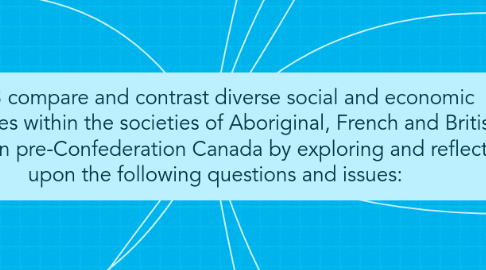
1. • What were the different ways in which Aboriginal societies were structured (i.e., Iroquois Confederacy, Ojibwa, Mi’kmaq)?
2. • What were the social and economic factors of European imperialism?
2.1. The countries built up resources they also discovered more lands/places. Were also able too meet new people and trade with them and establish allies. And lastly too see the world in a better view, they also had the chance to set up new colonies for pow
3. • Who were the key figures in the French exploration and settlement of North America?
4. • What roles did the Royal Government and the Catholic Church play in the social structure of New France (i.e., governor, intendant, Jesuits, religious congregations)?
4.1. The Royal Government was the highest official/highest in government. This is because they where very religious/catholic people.
4.2. The Church: had all the bishops which were very high in power.
5. • What role did the British government play in the settlement of North America?
5.1. They took the role of starting colonies and creating America as New England where they could tax the colony, set up trade and bring back wanted goods such as tobacco, fish and lumber.
6. <--Link here
7. <--link here
8. • How did the structures of Aboriginal societies affect decision making in each society (i.e., role and status of women, consensus building)?
8.1. Iroquis
8.1.1. There society was structured with different clans that are in different places so if you were part of a clan you would live in a longhouse with other clan members there was wolf clan, bear clan and more
8.2. Mi'kmaq
8.2.1. The Mi'kmaq territory was divided into seven traditional "districts". Each district had its own independent government and boundaries. The independent governments had a district chief and a council. The council members were band chiefs, elders, and other worthy community leaders. The district council was charged with performing all the duties of any independent and free government by enacting laws, justice, apportioning fishing and hunting grounds, making war, suing for peace, etc.
8.3. Ojibwa
8.3.1. They were a egalitarian society meaning they were all equal. Although women were considered inferior to men even though they did most of the hard work. The grand medicine society was an important society, the leadership worked like royalty when the chief died his son would take power. Familys were called clans, they were named after animals. Crane and loon clans were typically leaders in the tribe, the fish clan were the teachers and the scholars, the bear clan were the police or guardians in the tribe, the marten clan were in charge of hunting and fishing, the people of the bird clan were the spiritual leaders in the tribe.
8.4. Blackfoot
8.4.1. During the summer when the confederacy assembled for tribal ceremonies and hunting, the warrior societies would become active. Membership was not based on blood relation ship. A number of young men would purchase membership in the lowest society. Throughout their lives, they would continue to purchase membership in higher societies while selling their old positions to the new generation. These warrior societies acted as a police force, regulating camp moves and the communal hunt.
